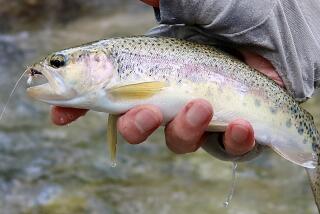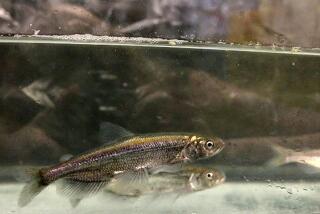There’s a Catch to This Run : Bay Area Striped-Bass Fishing Season Is Called Best in 10 Years, but as Far as Fishery Is Concerned, It Could Be the Worst
BERKELEY — Captain Jim Smith embarks from Berkeley Marina well before dawn, the Bay Bridge a neon yellow against the dark sky, the San Francisco skyline a faint orange through the thin mist.
The Happy Hooker glides past Alcatraz Island and beneath the Golden Gate Bridge, rounds Point Lobos and heads south toward Pacifica Beach, where Smith eventually settles directly atop a school of large fish.
Jim’s son, James, 17, tosses a few live anchovies overboard and almost instantly turns the placid striped bass into a mass of voracious feeders, at the same time galvanizing a sleepy group of fishermen.
The fishermen marvel, wide-eyed with excitement as they stumble to and from the bait tanks, stepping on each other’s toes, hastily grabbing at the liveliest of anchovies, then scrambling to bait their hooks and cast into the ocean.
Each holds his rod in anticipation of a strike that will engage him in battle with a tasty fish known for bold runs.
Stripers surface, creating huge swirling wakes, gulping anchovies tossed over the rail by the crew, then rapidly flee after swallowing the bait attached to hooks.
Surf fishermen have gathered along the shore. Wading knee-deep, they fling heavy lures beyond the crashing surf, seemingly oblivious to boats full of passengers in their lines of fire. The boats are, according to many on the beach, in too close and taking their fish.
Mindless of the apparent dangers of such a rivalry and thinking only of the task at hand, the Happy Hooker’s passengers go about their business.
Claude Dye of the San Francisco suburb of El Granada follows his fleeing fish up one rail and down the other before bringing it to gaff. Larry Green of San Francisco goes off in another direction, but his fish turns and darts beneath the boat. His rod bends downward, then snaps back with a twang when his line rubs against the hull and breaks.
Mansour Aliadadi of Sacramento, meanwhile, stumbles toward the bow, fighting his fish there for 30 minutes before James Smith sticks it with the gaff and plops it on the deck, which soon becomes littered with a flopping mass of pin-striped silver and black.
The commotion seems to last for hours, with many battles lost but enough won to enable the fishermen to bring home their limits, two fish apiece, ranging from 15 to 50 pounds.
Smith would again go home early.
“I’ve been tied up before noon this season (with early limits) more than I have in the past several years,” the weathered skipper says.
Roger Thomas, president of the Bay Area Fishermen’s Assn., called the numbers of fish caught and the length of this summer’s run exceptional, adding: “It’s like old times.”
Actually, that is not the case. The productivity of the old days, experts say, is as much a thing of the past as the days themselves.
“For one reason or another, a large number of fish congregated off beaches in the Pacifica area and they became vulnerable to the party boat fishery,” says Don Stevens, a Department of Fish and Game biologist based in Stockton.
As a result, they are calling this the best striped-bass season in as many as 10 years, yet from a fisheries standpoint it could be one of the worst.
Experts familiar with the fishery are not sure such an excellent season will be beneficial in the long run, to either the stripers or the fishermen.
“The bass fishing’s great right now, but the industry is hurt because it should be great for a longer period of time,” says Smith, 43, a Bay Area striper fishermen for the past 20 years.
Striped bass, introduced into the Sacramento-San Joaquin Delta in 1879 after arriving via train from New Jersey, once flourished in and beyond the Delta, spawning in spring and venturing into the Pacific in summer.
But times have changed, particularly in the past 15 years with water diversions and exports to other parts of the state leading factors of what many believe is an irreversible decline.
DFG biologists have identified Sacramento-San Joaquin Delta water diversions by the State Water Project and the Central Valley Water Project, and water export pumping facilities in the South Delta near Tracy, as the major factors causing the decline in young bass abundance since 1976.
Each year, millions of the anadromous fish--which do not require saltwater to survive--are either killed or taken down the systems, establishing some viable fisheries along the way.
“Some get killed, others go through screens and down canal systems,” Stevens says.
The annual count of young striped bass in the Sacramento-San Joaquin Estuary in 1991 is the fourth-lowest in the 32 years the DFG has surveyed spawning success of the species. That, in turn, has affected the adult population.
“There definitely has been a decline in the number of adults as a result of the decline in the production of young fish,” Stevens says.
The DFG’s 1990 estimate of adult striped bass utilizing the Delta was the lowest ever: 500,000 fish compared to a 1970 count of 1.8 million. Therefore, striped bass have taken a heavy hit as a result of their congregation along the San Francisco beaches.
“As a rule, we have not been all that concerned here that sportfishing will affect the population significantly,” says Terry Herrgessell, the supervisor at the Stockton office.
Yet, Smith returned to port almost every day in July and much of August with limits, and others reported similar success. Add the private boats that have joined in the assault, throw in the surf fishermen and there are several thousand adult stripers that will never spawn again.
“We really don’t have any evidence to say (this season has adversely affected the fishery), and I guess we’re hesitant to acknowledge that even that could happen because it would mean a whole new change in our sampling, which we haven’t done,” Herrgessell says. “We just don’t really know, to be honest with you, and I would hate to give an impression that we say, ‘Yeah it could happen.’ We just really don’t know.”
In a positive step aimed at maintaining a viable fishery in the Bay Area, the DFG has been operating a hatchery program since 1983, introducing 2 million to 3 million year-old striped bass into the Sacramento-San Joaquin Delta.
They have no estimates of how many fish become adults, but some are beginning to show at the docks, an indication that the program is somewhat successful.
“I personally think (stocking) is the best hope for getting the population back up,” Stevens says. “The problem being that environment is so (messed) up by diversion of water--I just don’t see any way we’re going to get there through natural production, unless there’s some major changes in the way water is managed in the system.”
Lee Miller, a state biologist involved in the hatchery program, says that the appearance of hatchery fish at the docks could have contributed to the success of the fleet this season, but voiced concern over whether the costly program will be able to keep up with California’s fast-growing population and the accompanying demand for water.
“If its a water export problem and there’s 30 million people in California now and millions more coming, then likely that’s going to get (worse),” Miller says.
Meanwhile, the bass fleet has dwindled to a handful of full-timers such as Smith, fishing the bay or beaches, and it figures to dwindle further if the fishery continues to plummet.
Smith says that in the previous two seasons, he had the beaches almost to himself, but his passenger loads were light and fishing was iffy enough to make him wonder about this season.
“I was ready to bail,” he says. “This boat was on its way to Homer (in Alaska) after 20-something years, then this season popped up.”
It may be on its way to Homer again soon.
More to Read
Sign up for Essential California
The most important California stories and recommendations in your inbox every morning.
You may occasionally receive promotional content from the Los Angeles Times.










